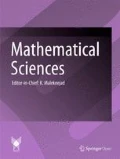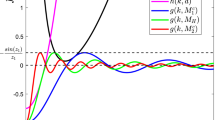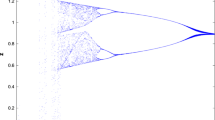Abstract
A class of non-autonomous two-species Lotka–Volterra predator–prey system with pure discrete time delays is discussed. Some sufficient conditions on the boundedness, permanence, extinction, positive periodic solution and global attractivity of the system are established by means of the comparison method, coincidence degree theory and Liapunov functional.
Similar content being viewed by others
Introduction
In the real world, there are many types of interactions between two species. Predator–prey relations are among the most common ecological interactions. Remarkably, the whole field of mathematical ecology began with the studies of population dynamics subject to the predator–prey interaction, that is, with the classical works by Lotka [1] and Volterra [2]. Traditional two-species non-autonomous Lotka–Volterra predator–prey systems take the form
Recently, the properties of system (1) are discussed by many scholars [3–7]. Some sufficient conditions are obtained for the persistence, permanence and extinction of the species, the existence and uniqueness of periodic solutions or almost periodic solutions, and the global stability of solutions for system (1).
However, in the real world, the growth rate of a natural species will not often respond immediately to changes in its own population or that of an interacting species, but will rather do so after a time lag [8]. Time delays have a great destabilizing influence on the species population; this result was put forwarded by May [9].
Therefore, we should introduce time delay into model foundation, which will have more resemblance to the real ecosystem.
In this paper, we investigate the following two-species Lotka–Volterra type predator–prey systems with pure discrete time delays
Our main purpose is to establish some sufficient conditions on the boundedness, permanence, extinction, positive periodic solution and global attractivity of the system (2).
The organization of this paper is as follows. In the next section, we will present some basic assumptions and main lemmas. In "Main results", we will consider conditions for the boundedness, permanence, extinction, positive periodic solution and global attractivity of the system. In the final section, as an application, one special case of the system is considered.
Preliminaries
In system (2), we have that is the prey population density and is the predator population density, and are the intrinsic growth rate and density-dependent coefficient of the prey, respectively, is the intrinsic growth rate of the predator, is the capturing rate of the predator and is the rate of conversion of nutrients into the reproduction of the predator. Throughout this paper, for system (2) we introduce the following hypotheses.
() are positive constants, are continuous -periodic functions with . are continuous positive -periodic functions.
From the viewpoint of mathematical biology, in this paper for system (2), we only consider the solution with the following initial condition:
where are nonnegative continuous functions defined on satisfying and .
In this paper, for any -periodic continuous function , we denote
To obtain the existence of positive -periodic solutions of system (2), we will use the continuation theorem. For the reader’s convenience, we will introduce the continuation theorem in the following. First we define some definitions.
Let and be two normed vector spaces. Let be a linear operator and be a continuous operator. The operator is called a Fredholm operator of index zero, if KercodimIm and Im is a closed set in . If is a Fredholm operator of index zero, then there exist continuous projectors and such that Im Ker and Im Ker Im. It follows that DomKer DomKer Im is invertible and its inverse is denoted by and denoted by an isomorphism of onto . Let be a bounded open subset of , we say that the operator is -compact on , where denotes the closure of in , if is bounded and is compact. Such definitions can be found in [10–12].
Now, we present some useful lemmas.
Lemma 1
Set is positively invariant for system (2).
The proof of Lemma 1 is simple, and here we omit it.
Lemma 2
[(see,[13])] Consider the following equation: , where , we have If . If .
Lemma 3
(see [4]) Let be a Fredholm operator of index zero and let be -compact on . If
-
(a)
for each and Dom, ;
-
(b)
for each Ker, ;
-
(c)
degKer,
then the operator equation has at least one solution lying in Dom.
Main results
In this section, we will obtain some sufficient conditions for the boundedness, existence of periodic solution, global attractivity, permanence, and extinction of system (2).
Theorem 1
Suppose that assumption (H1) holds, then there exist positive constants such that
for any positive solution of system (2).
Proof
Let be a solution of system (2). Firstly, it follows from the first equation of system (2) that for , we have
We consider the following auxiliary equation
By Lemma 2, we derive
By comparison, there exists a such that for .
Next, from the second equation of system (2) for , we have
We consider the following auxiliary equation
By Lemma 2, we derive
By comparison, there exists a such that for . This completes the proof.
Theorem 2
Suppose that assumption (H1) holds and . Then system (2) has at least one positive periodic solution.
Proof
Let
Then system (2) is rewritten in the following system
To apply Lemma 3 to system (4), we introduce the normed vector spaces and as follows. Let denote the space of all continuous functions . We take
with norm
It is obvious that and are the Banach spaces. We define a linear operator Dom and a continuous operator as follows.
and
where
Further, we define continuous projectors and as follows.
We easily see and . It is obvious that Im is closed in and dimKer. Since for any there are unique and with
such that , we have codimIm. Therefore, is a Fredholm mapping of index zero. Furthermore, the generalized inverse (to ) Im Ker Dom is given in the following form:
For convenience, we denote as follows
Thus, we have
and
From formulas (7) and (8), we easily see that and are continuous operators. Furthermore, it can be verified that is compact for any open-bounded set by using Arzela–Ascoli theorem and is bounded. Therefore, is -compact on for any open-bounded subset .
Now, we reach the position to search for an appropriate open-bounded subset for the application of the continuation theorem (Lemma 3) to system (2).
Corresponding to the operator equation with parameter , we have
where are given in Eq.6.
Assume that is a solution of system (9) for some parameter . By integrating system (9) over the interval , we obtain
By (10) we get ,
For each , we have
From the continuity of , there exist constants such that
From (11)–(13) and the condition of Theorem 2, we further obtain
where
and
Therefore, from (17), (18) we have
It can be seen that the constants are independent of parameter .
For any , from (5) we can obtain
where
We consider the following system of algebraic equations
By direct calculation we can get
From the assumption of Theorem 2, the system of algebraic equations has a unique positive solution . Hence, the equation has a unique solution .
Choosing constant large enough such that and , we define a bounded open set as follows
It is clear that satisfies conditions and of Lemma 3. On the other hand, by directly calculating we can obtain
where .
From the assumption of Theorem 2, we have
From this, we finally have
This shows that satisfies condition of Lemma 3. Therefore, system (4) has a -periodic solution . Hence, system (2) has a positive -periodic solution .
Theorem 3
Suppose that assumptions of Theorem 2 hold. Further suppose that the following () holds.
() There exists a constant such that
where
where and are defined in Theorem 1. Then system (2) has a positive periodic solution which is globally attractive.
Proof
From Theorem 2, we can obtain that system (2) has a positive periodic solution.
Let be a positive periodic solution of system (2) and be a any positive solution of system (2). From Theorem 1, choose positive constants , such that
where and for all . Let
Calculating the upper right derivation of along system (2) for all , we have
Define
where
Calculating the upper right derivative, from (20) we have
Define
where
Further, we define a Liapunov function as follows
Calculating the upper right derivation of , from (20) and (21) we finally can obtain for all
From assumption (), there exists a constant and such that for all we have
Integrating from to on both sides of (22) and by (23) produces
then
By the definition of and (24) we have
Therefore, for we have
which, together with (19), lead to
From the boundedness of and (25), it follows that are bounded for . From the boundedness of and we know that the derivatives and are bounded. Furthermore, we can obtain that and their derivatives remain bounded on . Therefore is uniformly continuous on . By Barbalat’s theorem it follows that:
Therefore,
This completes the proof of Theorem 3.
From the global attractivity of bounded positive solutions, we have the following result.
Corollary 1
Suppose that the conditions of Theorem 3 hold, then system (2) is permanent.
As a direct corollary of Lemma 2, we have
Corollary 2
Suppose that , then the predator species of system (2) goes to extinction.
Application
In this section, we will apply the results in Sect. 3 to the following predator–prey system with pure delays
Corollary 3
Suppose that assumption (H1) holds, then there exist positive constants such that
for any positive solution of system (29).
Corollary 4
Suppose that assumption (H1) holds and . Then system (29) has at least one positive periodic solution.
Corollary 5
Suppose that assumptions of Corollary 4 hold. Further suppose that the following () holds.
() There exists a constant such that
where
where . Then system (29) has a positive periodic solution which is globally attractive.
Corollary 6
Suppose that the conditions of Theorem 3 hold, then system (29) is permanent.
References
Lotka, J.A.: Elements of Physical Biology. Williams and Wilkins, Baltimore (1925)
Volterra, V.: Fluctuations in the abundance of a species considered mathematically. Nature 118, 558–560 (1926)
H.I. Freedman, Deterministic mathematical models in population ecology, in: Monogr. Text-books Pure Appl. Math., vol. 57, Marcel Dekker, New York, 1980.
Teng, Z.: Uniform persistence of the periodic predator-prey Lotka-Volterra systems. Appl. Anal. 72, 339–352 (1999)
Teng, Z., Li, Z., Jiang, H.: Pemanence criteria in non-autonomous predator-prey Kolmogorov systems and its applications. Dynam. Syst. 19, 171–194 (2004)
Teng, Z., Yu, Y.: The extinction in nonautonomous prey-predator Lotka-Volterra systems. Acta. Math. Appl. Sinica. 15, 401–408 (1999)
Zhao, J., Jiang, J.: Permanence in nonautonomous Lotka-Volterra system with predator-prey. Appl. Math. Comput. 152, 99–109 (2004)
Muhammadhaji, A.; Teng, Z.; Zhang, L.: Permanence in general nonautonomous predator-prey Lotka-Volterra systems with distributed delays and impulses, J. Biol. Syst. 21(2), DOI: 10.1142/S0218339013500125. (2013)
May, R.M.: Time-delay versus stability in population models with two and three trophic levels. Ecology 54, 315–325 (1973)
Muhammadhaji, A., Teng, Z.: Positive periodic solutions of n-species Lotka-Volterra cooperative systems with delays. Vietnam J. Math. 40(4), 453–467 (2012)
A. Muhammadhaji, Z. Teng, Global attractivity of a periodic delayed -Species model of facultative mutualism, Discrete Dynamics in Nature and Society, Vol. 2013, Article ID 580185, p 11
Niyaz T., Muhammadhaji A.: Positive periodic solutions of cooperative systems with delays and feedback controls, Int. J. Differ. Equ., 2013, 9, Article ID 502963 (2013)
Ma, Z., Li, Z., Wang, S., Li, T., Zhang, F.: Permanence of a predator-prey system with stage structure and time delay. Appl. Math. Comput. 201, 65–71 (2008)
Gaines, R.E., Mawhin, J.L.: Lecture notes in mathematics, vol. 568. Springer, Berlin (1977)
Acknowledgments
This work was supported by the National Natural Science Foundation of China (Grant Nos. 11401509,11271312, 11261056, 11261058).
Author information
Authors and Affiliations
Corresponding author
Rights and permissions
Open Access This article is distributed under the terms of the Creative Commons Attribution License which permits any use, distribution, and reproduction in any medium, provided the original author(s) and the source are credited.
About this article
Cite this article
Mahemuti, R., Muhammadhaji, A. & Teng, Z. Dynamics in a periodic two-species predator–prey system with pure delays. Math Sci 8, 71–77 (2014). https://doi.org/10.1007/s40096-014-0130-9
Received:
Accepted:
Published:
Issue Date:
DOI: https://doi.org/10.1007/s40096-014-0130-9




